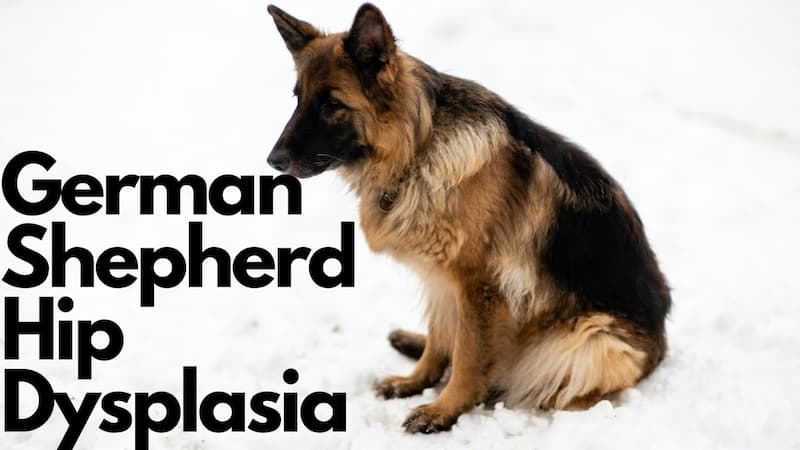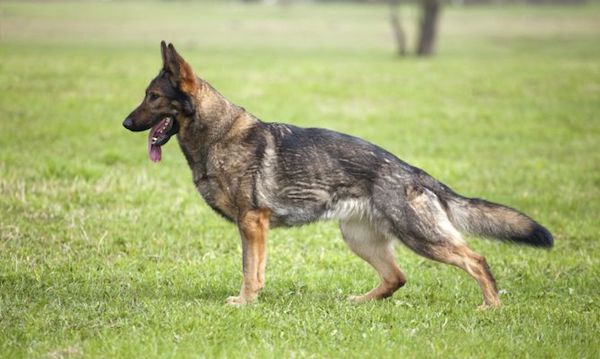German shepherd hip dysplasia is the most common issue. German Shepherds, like other large dog breeds, are prone to hip dysplasia. Although this is irreversible if they suffer from it, it is possible to help prevent it and limit your dog’s pain. Like all large breed dogs, german shepherds are at serious risk for hip dysplasia. It is estimated that 19% of German Shepherds will develop hip dysplasia, but some cases are worse than others.

German shepherd hip dysplasia is a congenital disorder in which the hips are too loose and the dog suffers pain in the femur. Dogs inherit this condition from their parents, which is why it is so important when purchasing a German Shepherd puppy to ensure that it is free of this congenital disease.
But if our German shepherd suffers from hip dysplasia the symptoms and consequences of this ailment can be improved or worsened through training and activity levels. Hip problems usually have developed by 4 months and get worse over time. In some cases, an injury to the hip can also start the process of dysplasia, even if the dog does not have the hereditary predisposition. Because they are very active dogs, German Shepherds are particularly at risk for these hip injuries.
Symptoms of German Shepherd Hip Dysplasia
There are many symptoms that may indicate that your German shepherd experiences pain or laxity in the joints, which may indicate that you have hip dysplasia, this mainly occurs in the Sable German Shepherd dog breeds. German Shepherds are very active and playful dogs, so a lack of interest in play may mean that they are in pain. Some of the warning signs can be:
- That the dog presents a weight gain
- Pain in the hip area
- Trouble standing up
- Limp
- Favor one leg when walking
- Running or walking in a “bunny hop,” using both legs together
- Problems or doubts when running
- reduced activity
- Hesitation when going up or downstairs
- Being aggressive, especially if the hip area is touched
If you see one or more of these symptoms, contact your vet for an x-ray to examine your dog’s hips. Your dog will likely need to be sedated for the procedure, but an X-ray is the best way to diagnose dysplasia.
German Shepherd Hip Dysplasia Prevention
Many of us want to know how to prevent german shepherd hip dysplasia. If you have a German shepherd hip dysplasia, especially a puppy, there are steps you can take to reduce your risk of hip dysplasia, or at least the severity of it. Taking good care of a puppy’s joints can make a big difference in the future of a dog with hip dysplasia.
- The first step is to find a responsible or certified breeder. German Shepherds with hip dysplasia should never be bred, so verifying that the breeder has the corresponding certificate for the German shepherd puppy that you want to acquire may be the best guarantee to prevent your future pet from suffering from dysplasia. Police dog trainers, for example, are always very careful to select bloodlines without dysplasia.
- During the first months, German shepherd hip dysplasia in puppies grow very fast, often eating too many calories, if their hips do not grow and strengthen at the proper rate and according to their weight it can lead to the appearance of dysplasia.
- It is important to control the feeding of your german shepherd puppy, controlling the quality and quantity of the portions of your diet. Your vet may recommend using adult food instead of high-calorie puppy food. Throughout his life, be sure to keep your dog’s weight in a healthy range, as obesity complicates joint problems.
There are also some behaviors that can help prevent joint damage. German Shepherd puppies need plenty of moderate exercise, but most people only have time for one strenuous outing a day. Try to break up the puppy’s activity into several short walks rather than one very intensive one, and avoid horseplay or long periods of running. Jumping can also cause problems of hip dysplasia german shepherd, so don’t let your pup jump up and down on a regular basis, just as it’s good to avoid going up and down stairs whenever possible.
Treatment of hip dysplasia in the German Shepherd
Since German shepherd hip dysplasia worsens over time, treatments aim to slow its development, relieve pain, and/or improve mobility. Here are some tips that can alleviate the symptoms and pain caused by hip dysplasia in your German Shepherd dog, but don’t forget that the best advice can be given by a veterinarian who has examined your pet.
- The first step may be to help your German Shepherd lose weight on a low-calorie diet, so it puts less stress on the joints.
- Moderate exercise is best for dogs with dysplasia. Short walks and swimming are great ways to build muscle to support loose joints.
- Your vet may prescribe anti-inflammatory medications or pain relievers.
- A special diet with supplements to maintain joint health can make a big difference.
- A warm bed can help your dog sleep better and ease pain.
- If you have slippery floors, it’s best to provide some traction so your dog doesn’t slip and re-injure his hip.
- In some cases, surgery is the best option. Some puppies with severe dysplasia may be recommended for less intensive corrective surgery. In other cases, adults with severe arthritis and joint damage may need a hip replacement or surgery to remove the head of the femur.
German Shepherds are wonderful, highly active dogs that often have a great quality of life, even with hip dysplasia, for more information visit Germanshepherdss.com and by following the tips we’ve listed and using some preventative strategies, you should be able to avoid the worst symptoms of German shepherd hip dysplasia. And do not forget that the best advice and/or prescription will always be that of a veterinarian who has observed your dog

